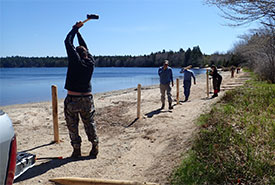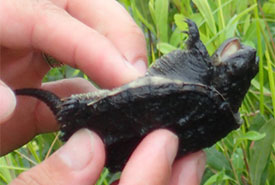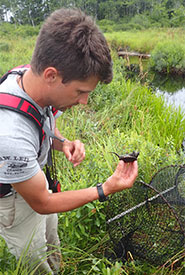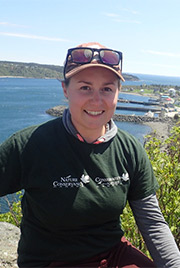Surveying turtles at NCC's Silver River property

Conservation Volunteers installing fence posts at Turtle Beach (Photo by NCC)
The second week of August has been all about turtles for our team here in Nova Scotia! We had the opportunity to meet with Brad Toms, a researcher from the Mersey Tobeatic Research Institute, at the Nature Conservancy of Canada’s (NCC’s) Silver River property. Toms and his team have been working with endangered turtles in the region, including Blanding’s turtles in Kejimkujik National Park, and are investigating the health and population size of the snapping turtles at Silver River for us this year.
The Silver River property in southwest Nova Scotia encompasses extensive lake shoreline as well as sections of the Silver River and Caribou River. This watershed is home to the snapping turtle: a species so old, its ancestors rubbed shoulders with dinosaurs.

Juvenile snapping turtle (Photo by NCC)
Snapping turtles have been around on this planet for longer than most other species here today. But unfortunately for these turtles, their future is threatened. Snapping turtles are listed as vulnerable in Nova Scotia and have been facing population declines largely due to human activity through pollution, shoreline development, vehicle mortality and illegal harvesting. An adult snapping turtle does not reach breeding age until 15–20 years old and tends to have low nesting success, which means that the loss of even one mature adult can be very detrimental to the overall health of the population. The most vulnerable time in a snapping turtle’s life cycle is during incubation of the eggs and the first year of the turtle’s life when they face high mortality rates due to predation.
A prominent site for snapping turtle activity on the Silver River property is the aptly named Turtle Beach, along Long Tusket Lake. Turtle Beach is an important nesting ground for snapping turtles and a central focus for NCC’s conservation work on the property. This is where we met up with Brad and checked in on some conservation work completed in preparation for snapping turtle nesting season earlier this spring!
Back in May, we held a Conservation Volunteers event at Turtle Beach to remove litter, rope off sensitive areas and install signage. The day was a great success, with a great turnout of volunteers who helped to pound in a truckload of fence posts along the beach. In doing so, we created a designated trail for ATVs to cross the beach while leaving most of the beach untouched where the turtles could nest safely.
In our August visit we came across a nest on the beach that had come to an untimely demise: it had been predated, most likely by a racoon, and only egg shells remained. While this is very sad to see, this nest was right up at the top of the beach, just inside our fence. Turtle nests are well camouflaged in the sand and are not very visible to the untrained eye as you cross the beach. The predated nest tells us that the turtles are indeed using the entirety of the beach and would have undoubtedly been squashed by unknowing ATV users if that fence were not there.

Brad Toms with juvenile snapping turtle (Photo by NCC)
During this visit, we helped Toms and his assistant pull in some traps along the stream that passes midway through Turtle Beach. These live traps allow turtles to be caught and released without harm, while allowing the researchers to collect important information about the individuals. Of the six traps that were deployed, only two had turtles: one a painted turtle and, much to our excitement, the other a juvenile snapping turtle! Brad estimated this tiny turtle to be three years old.
The presence of juveniles in this area is very encouraging; it means the young are surviving past the most vulnerable stage and making it into the surrounding waterways. The low numbers of individuals that were seen during this survey, though, means that we still have work to do to help stabilize this population. We hope our work this summer will make the beach safer for the turtles to nest on and also help educate visitors of the importance of this beach to these threatened turtles.
Snapping turtle eggs are currently incubating in the nests and will start to hatch around October, so if you are in the area, keep an eye out for these tiny (adorable!) baby turtles coming soon!


